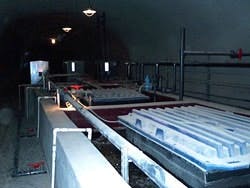Napa Winery Treats Wastewater in an Onsite Cave
Wine caves are growing increasingly popular in California’s wine country. This is especially true in Napa County, Calif., where there are more than 100 wineries utilizing a wine cave in its operation.
Caves are beneficial because they provide environmental benefits while preserving land to plant vineyards. There is one Napa winery in particular that is setting a new course within this trend. The Palmaz Winery is treating wastewater in a cave, and treating it fast.
The winery
Palmaz Winery’s state-of-the-art, four-level cave is massive enough to house offices, the entire winery operation, a collection of antique race cars, a tasting room, two 12-story elevators, and there is still enough space for a high-strength Winery FAST wastewater treatment system by Smith & Loveless Inc.
During the design phase, the winery’s engineering consultant worked closely with Smith & Loveless, the contractor, and state and local authorities. The wastewater treatment system had to maintain a zero water impact on the surrounding community, while still fitting comfortably in the underground chamber.
Flow scheme
In the winery’s system, waste streams from operations collect in a wet well/holding tank where it is then pumped through a rotary screen into an equalization basin. The equalized flow enters the two-stage Winery FAST at a rate of 1,000 gpd. When the winery is not going through harvest, the system handles the flow in only one stage, treating the flow to below 50 mg/l. When the crush season begins, the higher strength flow, which can range up to 10,000 mg/l BOD, goes through a second stage FAST zone.
Each zone contains FAST media, a submerged fixed film upon which a healthy biomass grows and works to degrade the waste stream’s constituents.
Air diffusers provide circulation of the waste to be treated through the media and oxygenation to the liquid. The bacteria grow on the media, while the liquor circulating through the bacteria-laden media is essentially clear and free of suspended solids. Because the bacteria are fixed to the media, shock loads can be more easily tolerated and treated. Solids are prevented from being washed out, yielding stable, hassle-free operation.
Finally, the bacterial growth reaches a point where it sloughs from the media. The solids that are removed by this sloughing action are not overly gelatinous and slimy, but tend to be very large and settle very rapidly.
The location inside a cave benefits the process because it provides a temperate climate with temperatures continually ideal for the bacteria to operate effectively. Sloughed solids (sludge) collect into a sludge holding zone for further digestion.
Periodically, the inert solids are collected and re-used for soil amendments in the vineyard.
Meanwhile, the clear, odorless effluent emanates from the system’s small hopper-style clarifier and is stored for eventual reuse by drip-irrigation.
After more than a year of operation, the Winery FAST continues to easily meet permit requirements. Sample test results demonstrate BOD reduction of 99% (less than 15 mg/l BOD) and 94% of TSS. Operators report how pleased they are with the system’s ability to handle spikes and its ease of operation.
Therefore, wineries can focus on the making of exquisite wines, rather than wastewater hassles.
